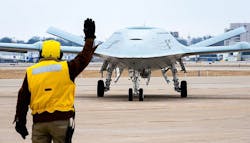Unmanned aerial vehicles (UAVs) may fill gaping hole in aircraft carrier submarine defenses
The Military & Aerospace Electronics take:
2 Jan. 2019 -- But the centerpiece of the US Navy's fleet has a decade-old gap in its submarine defenses, and filling it may require new, unmanned aircraft.
During the Cold War and the years afterward, aircraft carriers had fixed-wing aircraft and helicopters for anti-submarine-warfare (ASW) operations. For much of that period, the fixed-wing option was the S-3 Viking.
Unmanned systems — sensors as well as unmanned underwater and surface vehicles — are seen as an option to extend the carrier's reach. The Navy has already awarded Boeing a contract for unmanned aerial refueling vehicles.
Related: New era dawns in ASW as manned and unmanned submarines team for bistatic sonar
Related: BAE Systems to develop MAD ASW drone to help Navy P-8A find submarines from high altitudes
Related: Navy places order for 166,500 anti-submarine warfare (ASW) sonobuoys in $219.8 million deal
John Keller, chief editor
Military & Aerospace Electronics
Ready to make a purchase? Search the Military & Aerospace Electronics Buyer's Guide for companies, new products, press releases, and videos
